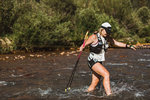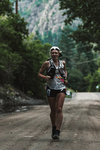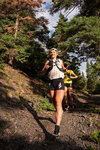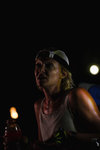



Disaster struck early in Sabrina Stanley’s defense of her Hardrock 100 title.
The 2008 Onalaska graduate has spent the past six years transforming herself from a hobby runner into one of the top women ultrarunners in the world. Stanley, who is sponsored by Adidas, hasn’t lost an ultramarathon since January 2018, a streak of 13-consecutive victories.
She entered the 2021 edition of the Hardrock 100 as the defending champion, having won the race the last time it was held in 2018.
The grueling 100-mile contest, one of the toughest mountain races in the world, snakes through the San Juan Mountains, a rugged range that forms the southern portion of Colorado’s Rocky Mountains.
Not only did Stanley want to win and defend her title, but she hoped to beat Diana Finkel’s course record of 27 hours, 18 minutes and 24 seconds, set in 2009.
With record-breaking aspirations on her mind, a title to defend and win streak on the line, prospects were already looking dim just 10 miles into the race on July 16.
Game Plan
The Chronicle last wrote about Stanley in October 2020 after she reclaimed the Fastest Known Time (FKT) in the Nolan’s 14, a 95-mile ultramarathon that traverses 14 Colorado peaks. Since then, most competitions have been canceled due to the pandemic.
She did compete in a 50k race in North Carolina in May 2021, which she won and used as a training run for the upcoming Hardrock 100. She also served as a pace runner for teammate and friend Abby Hall in the Western States Endurance Run.
Since then, she’s been training around Silverton, Colorado, where she lives with her boyfriend and fellow runner Avery Collins.
Silverton is also the start and finish line for the Hardrock 100’s looped course that saddles nine mountain peaks and boasts 33,050 feet of climb and 33,050 feet of descent. The punishing 11,000-foot-average altitude pushes many runners to their breaking point.
Stanley’s plan was to run conservatively for the first 50-60 miles before slowly putting her foot on the gas. By mile 75, she planned to stomp on the pedal and finish strong in an attempt to break the FKT.
Ready, Set, Go
On July 16, Stanley felt great out of the starting gate and was soon running much faster than anticipated. She reached the first aid station, the 10-mile mark, 30 minutes ahead of schedule.
The problem was, there is just one shuttle that travels to that location and only one person from her support crew was at the checkpoint when she arrived. The rest of the crew had her second pack, which contained everything she needed to reach the next aid station.
Her pack typically holds four or five 200-calorie liquid energy gels, ginger chews to help with nausea, salt tabs, caffeine tabs, TUMS, two water bottles and, depending on the weather, a rain jacket and gloves.
Her lone crewmember had just two water bottles. She was so thrown off that she didn’t allow herself to calm down and accept the water. With no second pack available, she took off from the aid station and kept pushing.
“I immediately realized how big of a mistake I had made,” Stanley said. “Now I have 8 really tough miles and I was running out of water and nutrition electrolytes.”
Not only that, the next aid station was not a crew aid station, so Stanley would have to take whatever food and liquids were available there rather than having her own supplies.
About five minutes after leaving the first station, her quads began seizing up. She was in the lead at that point and began telling herself to walk as fast as she could up the hill, trying to hide the amount of pain her legs were in from the other runners.
“Once I got salt and electrolytes, I knew I would come back around,” Stanley said. “I just had to make it through those 8 miles, however slowly it went.”
Having trained on this course many times, Stanley had one saving grace. She knew there was a small stream at the top of the climb where she could fill her water bottle.
When she reached the top, a sheep herder and 200 sheep were standing in the creek. She knew it wasn’t a great idea to risk drinking the water and contracting giardia, a tiny parasite that causes diarrhea and is found in water that’s contaminated with feces.
“I had to. I didn’t really have an option,” Stanley said. “I just figured, if I get sick, I’ll deal with that after the race.”
Backup Plan
She finally arrived at the next aid station at mile 18 and drank an entire jar of pickle juice, which contains electrolytes and helps hydration.
Her body was still out of whack for the next 10 or 15 miles from being so depleted early on. She took a controlled effort in her pace and reached the third aid station 30 minutes behind the leader, Courtney Dauwalter, an elite ultrarunner who owns multiple FKTs.
Though Stanley had started off fast and then dropped off, she was not worried. She had moved into her planned original pace and was right on track right where she wanted to be.
Next she reached Handies, a huge climb that is the highest peak of the course at 14,048 feet. It rained her entire ascent, which was a plus for Stanley because it cooled her body that had grown hot from a lack of electrolytes.
She kept a consistent pace through the rain before reaching the fourth aid station at mile 42, where she picked up her friend, Abby Hall, who would serve as a pace runner for the next 14 miles.
After nine miles uphill and five downhill, Stanley entered the fifth aid station right on target but still trailed Dauwalter by 30 minutes.
“Which I was still fine with because I knew I still hadn’t fully started racing-racing,” Stanley said. “I was just trying to get to a point where there was enough space left in the race where I could race, but also maintain that effort until the end and be super strong all the way through.”
She then began a 13-mile climb that she loved and had run many times in the past. She picked up a new pacer, Devon Olson, and the two picked up a quicker pace to chip away at Dauwalter’s lead.
About four miles in, around mile 62, the two came across Dauwalter sitting cross-legged on the side of the trail. Stanley asked if she was OK, she said she was and Stanley kept climbing. She would later learn that Dauwalter had dropped out of the race due to stomach issues.
Stanley reached Telluride aid station which was about a marathon-distance away from the finish line. There, she picked up her boyfriend, Collins, before beginning the worst part of her day. It was the middle of the night, she was vomiting, going to the bathroom a lot and couldn’t retain enough calories. She pushed on the best she could before hitting the descent.
From there, she reached Chapman aid station, the final crew station in the race. After a five-minute refueling break, she headed out for the final two major climbs left on the course.
Push it to the Limit
Her pace soon began dropping off more than she anticipated due to the lack of calories, which sapped her energy. That also meant she couldn’t take caffeine, so she was getting groggy while trying to keep forward momentum.
The rising sun meant she had one more big climb left in the race. She was pretty beat up after reaching the top and knew she had a 7-mile descent to the finish line. She increased her speed the further down she got before reaching a familiar river crossing, Mineral Creek, 2 miles from the finish line.
That’s when she knew.
“I knew the course record was out of the game plan at that point,” Stanley said. “I still wanted to get as close to it as I could.”
Stanley flew across the river, reached Silverton and sprinted the final stretch as a line of spectators cheered and clapped. She reached the giant rock at the finish line and kissed it in a time of 27 hours, 21 minutes and 48 seconds, beating the runner-up by nearly five hours.
In all, she trekked 100.5 miles and finished sixth overall, beating out 127 men. It was the second-fastest women’s time in history, just three minutes and 31 seconds behind Finkel’s record. It was also over three hours faster than her winning time in 2018.
“I’m really proud of how fast I ran those last two miles,” Stanley said. “Just fell a little bit short, but it was still a really great day all in all.”
New Horizons
Stanley has now completed 26 races since taking up competitive racing and perhaps the biggest one of her career is just around the corner. The Ultra-Trail du Mont-Blanc (UTMB) is basically the World Series of ultramarathons and it begins Aug. 23.
The UTMB, considered one of the most difficult foot races in the world, is 107 miles of punishment through the Mont Blanc massif, a mountain range in the Alps situated in France, Italy and Switzerland. The race, part of a week-long festival, starts and ends in Charmonix, France, and has a staggering 32,808 feet of vertical gain across 10 alpine summits.
Ideally, Stanley would take a six-month break in between 100-mile races. Now she has just 37 days to prepare for a competition that will feature the top ultrarunners in the world.
“That’s a little daunting to think about at this point in time,” Stanley said. “It’s the most competitive 100 in the world.”
For now, she plans to rest for the next few days and feel out how well recovery from Hardrock goes. She’s obviously in peak physical shape, so now it’s just about making sure her muscles are repaired and ready to go.
“I’m not going to jump on a start line if I feel injured in any way,” Stanley said. “I want to set myself up for success and for a long career.”
If all goes to plan, Stanley will fly out to France and begin her training there on July 27. Running in the UTMB has always been a dream of hers and she had planned to run in the event in 2020 before it was canceled.
With a quick turnaround, Stanley hopes to be one of the few runners who have raced in the Hardrock 100 and UTMB back-to-back and finished at their full potential.
“This race, I’m kind of looking at as getting some intel, learning the course and learning the environment, because I’ve heard the environment is insane,” Stanley said. “There’s like helicopters and cameras everywhere, thousands of people and it’s televised. It’s a really big deal over there.
“If I can just get some experience being over there, being in the environment then go over in 2022 and be 100% prepared, that would be the goal.”